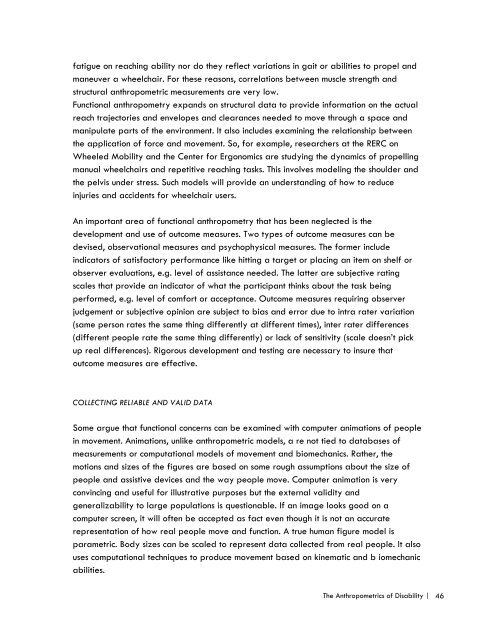The Anthropometrics of Disability - Designing Accessible Communities
The Anthropometrics of Disability - Designing Accessible Communities
The Anthropometrics of Disability - Designing Accessible Communities
You also want an ePaper? Increase the reach of your titles
YUMPU automatically turns print PDFs into web optimized ePapers that Google loves.
fatigue on reaching ability nor do they reflect variations in gait or abilities to propel and<br />
maneuver a wheelchair. For these reasons, correlations between muscle strength and<br />
structural anthropometric measurements are very low.<br />
Functional anthropometry expands on structural data to provide information on the actual<br />
reach trajectories and envelopes and clearances needed to move through a space and<br />
manipulate parts <strong>of</strong> the environment. It also includes examining the relationship between<br />
the application <strong>of</strong> force and movement. So, for example, researchers at the RERC on<br />
Wheeled Mobility and the Center for Ergonomics are studying the dynamics <strong>of</strong> propelling<br />
manual wheelchairs and repetitive reaching tasks. This involves modeling the shoulder and<br />
the pelvis under stress. Such models will provide an understanding <strong>of</strong> how to reduce<br />
injuries and accidents for wheelchair users.<br />
An important area <strong>of</strong> functional anthropometry that has been neglected is the<br />
development and use <strong>of</strong> outcome measures. Two types <strong>of</strong> outcome measures can be<br />
devised, observational measures and psychophysical measures. <strong>The</strong> former include<br />
indicators <strong>of</strong> satisfactory performance like hitting a target or placing an item on shelf or<br />
observer evaluations, e.g. level <strong>of</strong> assistance needed. <strong>The</strong> latter are subjective rating<br />
scales that provide an indicator <strong>of</strong> what the participant thinks about the task being<br />
performed, e.g. level <strong>of</strong> comfort or acceptance. Outcome measures requiring observer<br />
judgement or subjective opinion are subject to bias and error due to intra rater variation<br />
(same person rates the same thing differently at different times), inter rater differences<br />
(different people rate the same thing differently) or lack <strong>of</strong> sensitivity (scale doesn’t pick<br />
up real differences). Rigorous development and testing are necessary to insure that<br />
outcome measures are effective.<br />
COLLECTING RELIABLE AND VALID DATA<br />
Some argue that functional concerns can be examined with computer animations <strong>of</strong> people<br />
in movement. Animations, unlike anthropometric models, a re not tied to databases <strong>of</strong><br />
measurements or computational models <strong>of</strong> movement and biomechanics. Rather, the<br />
motions and sizes <strong>of</strong> the figures are based on some rough assumptions about the size <strong>of</strong><br />
people and assistive devices and the way people move. Computer animation is very<br />
convincing and useful for illustrative purposes but the external validity and<br />
generalizability to large populations is questionable. If an image looks good on a<br />
computer screen, it will <strong>of</strong>ten be accepted as fact even though it is not an accurate<br />
representation <strong>of</strong> how real people move and function. A true human figure model is<br />
parametric. Body sizes can be scaled to represent data collected from real people. It also<br />
uses computational techniques to produce movement based on kinematic and b iomechanic<br />
abilities.<br />
<strong>The</strong> <strong>Anthropometrics</strong> <strong>of</strong> <strong>Disability</strong> | 46


